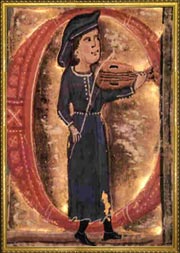
The transmission of a troubadour's song began the moment of its creation, continued through each performance, and included at some stage its written preservation. A troubadour composed for a hearing; the instant of composition itself probably coincided with a performance, whether before an audience or not, and whether written down or not. As long as a song was sung, it obviously had an oral tradition; the written tradition began when a scribe translated the words into letters and the music into neumes [notes] on parchment - perhaps contemporaneously with the troubadour, perhaps later. Composing, performing, and writing probably did not follow a diachronic sequence, one after the other, but were somehow synchronous. Each song had a unique life of creation and dissemination, involving both oral and written stages, and we do not know how long (or whether) a given song existed before it was written down, how performance and writing interacted, in what order the occured, or what stage was more influential in the formation of the song that we have finally received.
About forty manuscripts and fragments transmit Occitanian literature of the twelfth and thirteenth centuries, including didactic, epistolary, and epic texts, and over 2,500 lyric poems, most of them in more than one reading. Only two of these manuscripts transmit music. More than half of the surviving manuscripts were produced not in southern France, but in Italy. None of them can be dated securely before the fourth decade of the thirteenth century, and almost half were copied in the fourteenth century. Many sources survive in fragmentary or mutilated condition. The processes of compilation, including mise on page and order of the entry of the texts, decoration, and music, as well as the hierarchy and sectionalization of contents, differ radically not only from source to source but often even within a manuscript. Rubrics with composer attributions are often lacking, erroneous, or conflicting; and it is impossible to be certain that these rubrics refer to the melodies as well as the poems.
Both the immediate and the more distant exemplars for the extant texts and melodies are shrouded in mystery. Manuscripts have been lost, some perhaps as a result of the Albigensian Crusade, whose ill effects may have stifled the very craft of producing manuscripts in Languedoc annd Provence. Each chansonnier [songbook] that survives appears to have had several exemplars [models], both for text and for music, and there are few clear-cut filial or lateral relationships among the large collections. Some songs probably had short and uncomplicated lives, while others traveled a serpentine path to reach the extant codices; the history of a chansonnier must be the sum of the histories of every song it contains.
from Elizabeth Aubrey, The Music of the Troubadours (Bloomington, 1996) 26--27.